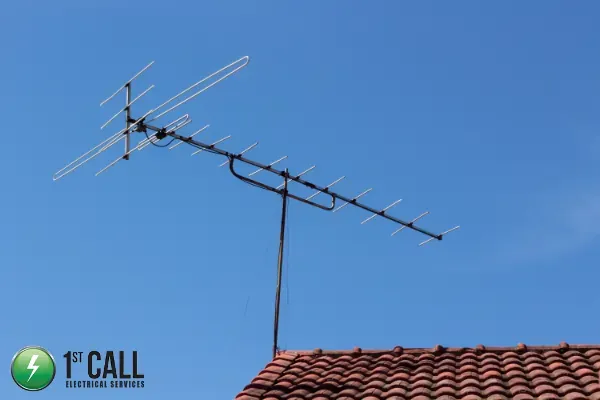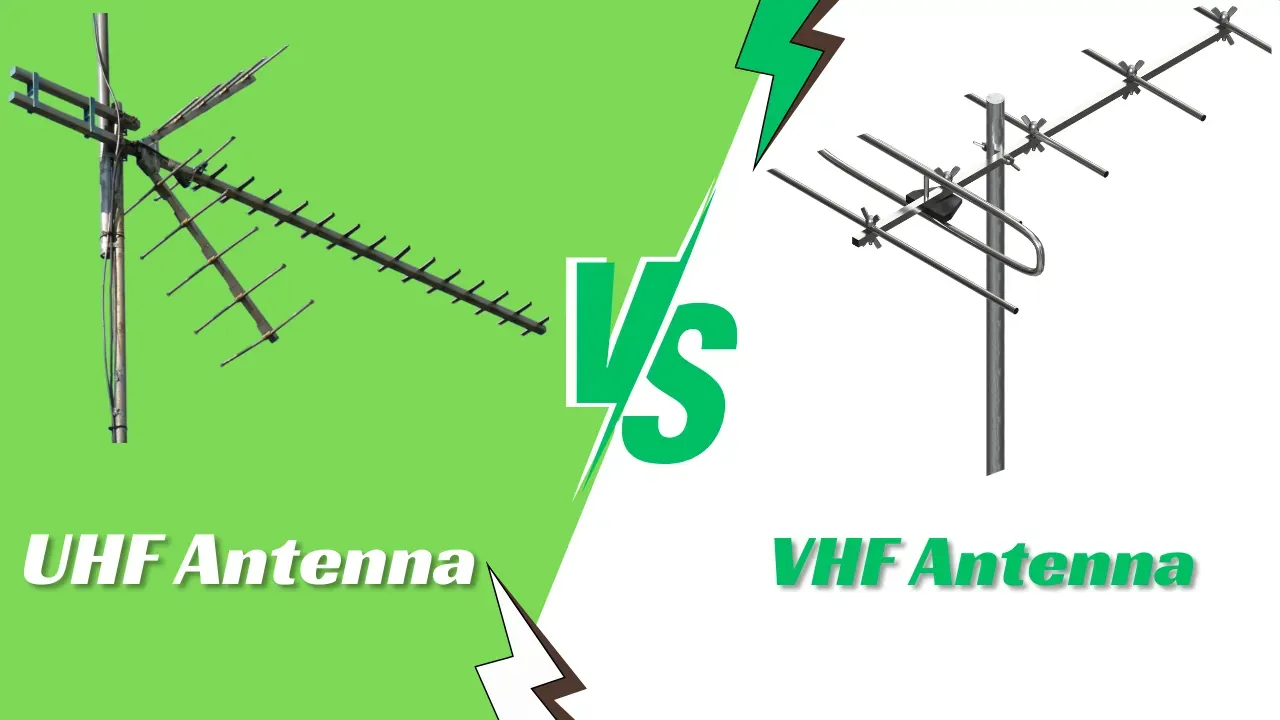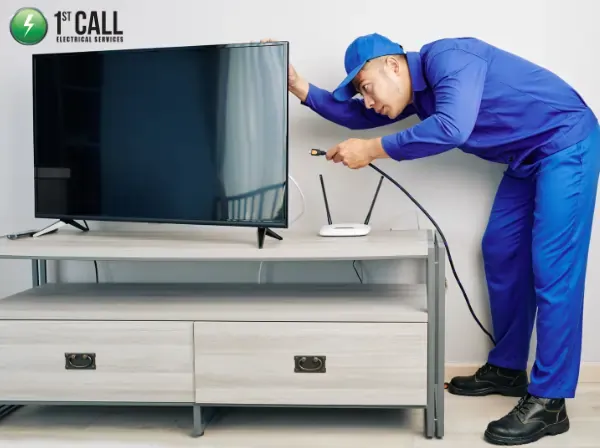How To Install a TV Antenna & TV Antenna Installation Costs
Enjoy crystal clear television with a properly installed TV antenna. Whether you're considering a DIY approach or prefer the expertise of professionals, this guide from First Call Electrical covers everything you need to know about TV antenna installation.
We discuss how to choose the right antenna, provide a step by step installation guide, and the benefits of professional installation. We'll also break down TV antenna installation costs so you can make the best choice.

Understanding TV Antenna Installation
Choosing and installing a TV antenna can seem complicated with so many options and information available, but understanding the basics can simplify the process. This section covers the different types of antennas, how to choose the right one for your location, and the essential tools you'll need if you decide to tackle a DIY installation.
Types of TV Antennas
Different antennas are designed to receive different types of signals. Here's a quick overview:
📺 VHF Antennas (Very High Frequency)
These larger antennas are designed to receive VHF signals, which are still sometimes used for free to air channels. They require more precise aiming and need to be pointed just right to work well.
📺 UHF Antennas (Ultra High Frequency)
Smaller and more compact than VHF antennas, UHF antennas receive signals for digital channels. Most digital TV broadcasts are now in the UHF band.
📺 Combo Antennas (VHF/UHF)
These antennas combine elements of both VHF and UHF antennas, allowing you to receive a wider range of channels. They are the most popular choice for most in Melbourne.
📺 Outdoor Antennas
These are mounted on the roof, in the attic, or on a pole, offering the best reception but requiring more complex installation.
📺 Indoor Antennas
These smaller antennas sit inside your home and are suitable for areas with strong signal strength. They are less effective in areas further from broadcast towers.

Choosing the Right Antenna for Your Location
Selecting the right antenna is crucial for optimal reception. Several factors come into play:
❓ How far from the tower? The farther you are, the stronger antenna you need.
❓ What's the land like? Hills, trees, and buildings can block signals. You might need a higher antenna or one that points in a certain direction.
❓ How strong is the signal? You can use websites (like [mention specific website or app if applicable]) to check the signal strength where you are. This will help you figure out what kind of antenna you need. A weak signal might mean you need an amplifier.
❓ What channels do you want? Knowing this will help you decide if you need a VHF, UHF, or combo antenna.
Essential Tools and Equipment For DIY TV Antenna Installation (If You're Doing it Yourself - Be Careful!)
If you're considering a DIY installation, you'll need the following tools and equipment:
⚒️ Antenna: The chosen antenna based on your location and needs.
⚒️ Coaxial Cable: To connect the antenna to your TV. Ensure you use high quality, weatherproof cable.
⚒️ Mounting Hardware: This will vary depending on where you're mounting the antenna (roof mount, attic mount, pole mount, etc.).
⚒️ Tools: Wrenches, screwdrivers, drill (if needed), cable stripper, crimping tool.
⚒️ Ladder: For accessing roof or attic installations. (Safety is paramount – consider hiring a professional if you're not comfortable working at heights)
⚒️ Signal Meter (Optional but Recommended): This tool can help you fine tune the antenna's position for optimal signal strength. However, they cost extra though.
Getting all these tools can make DIY installation expensive. Plus, using them safely can be tricky. A lot of people find it's easier and safer to just hire a professional.
DIY TV Antenna Installation: A Step by Step Guide (Proceed with Caution!)
Installing a TV antenna yourself is possible, but it's important to understand that it can be tricky and even dangerous. Working at heights, handling tools, and dealing with electricity can be risky. If you're not comfortable with any of these things, it's much safer to hire a professional.
This guide is for informational purposes only, and we strongly recommend considering professional installation.
1️⃣ Safety First!
‼️Heights are dangerous: Working on a roof or ladder is risky. If you're not experienced, please don't do it. A fall can cause serious injury.
‼️Electricity is dangerous: Make sure no power lines are near where you're working. If you're unsure, call an electrician.
‼️Tools can be dangerous: Use tools correctly and wear safety glasses.
2️⃣ Mounting the Antenna
🟢 Where to mount: Ideally, mount the antenna as high as possible, either on your roof, in your attic, or on a pole. The higher, the better the reception.
🟢 Attaching the mount: Follow the instructions that came with your antenna mount. Make sure it's securely attached. If you're mounting on the roof, make sure you're not damaging any shingles.
🟢 Attaching the antenna: Attach the antenna to the mount, again following the instructions. Make sure it's stable and won't move around.
3️⃣ Connecting the Coaxial Cable
🟢 Connecting to the antenna: Carefully attach one end of the coaxial cable to the antenna. Make sure the connection is tight and weatherproof. You might need to use a special sealant to protect it from the weather.
🟢 Running the cable: Run the cable from the antenna to your TV. Try to keep the cable neat and tidy, and avoid sharp bends. You might need to drill a hole through a wall to get the cable inside.
🟢 Connecting to the TV: Connect the other end of the coaxial cable to the "RF In" or "Antenna In" port on your TV.
4️⃣ Tuning Your TV
🟢 Scanning for channels: Use your TV's menu to scan for channels. This will tell your TV to look for all the available over the air channels.
🟢 Fine tuning (this can be tricky!): Sometimes, you might need to adjust the antenna's position to get the best signal. This can be a trial and error process, and it's where a signal meter can be helpful.
5️⃣ Troubleshooting
❓ No signal: Double check all your connections. Make sure the antenna is pointed in the right direction. You might need to adjust the antenna's position or try a different antenna.
❓ Weak signal: This could be due to distance from the towers, obstructions, or a poor connection. You might need a signal amplifier.
❓ Pixelation: This means your signal is weak or unstable. Try adjusting the antenna or checking your connections.
Important Reminder: DIY antenna installation can be challenging and dangerous. If you're not comfortable with any of these steps, or if you encounter any problems, it's always best to call the professionals at First Call Electrical. We have the experience, tools, and safety training to ensure a safe and effective installation.

Why Choose Professional TV Antenna Installation?
Setting up a TV antenna can be done yourself or by a professional. Both ways have good and bad points.
DIY might seem good if you want to save money and like learning new things, but it can be tricky and even dangerous.
Professionals know what they're doing, make sure things are done right, and offer warranties, but they cost more.
Whether you do it yourself or hire someone depends on how much money you have, how comfortable you are with DIY projects, and how important it is to you that the antenna works perfectly.
TV Antenna Installation Costs: What to Expect
How much it costs to get a TV antenna installed can change depending on a few things. Knowing what these things are will help you plan your budget and avoid surprises.
Doing it yourself might seem cheaper at first, but you have to think about the cost of tools, equipment, and fixing any mistakes you might make. Hiring a professional costs more upfront, but they'll do a good job, know what they're doing, and usually offer warranties, so it's often a better deal in the long run.
Here are the main things that change the price of getting a TV antenna installed:
📺 What kind of antenna? Bigger, stronger antennas that can pick up signals from far away or specific channels cost more than small, indoor antennas.
📺 How hard is it to install? Putting an antenna on a high roof or in a hard to reach spot costs more than a simple installation. Difficult jobs might need extra tools or more time.
📺 What kind of mount? The type of mount you need (for the roof, wall, or a pole) changes the price.
📺 Cables and wires: How much cable you need and if new wires need to be run will affect the cost. Running cables through walls can make the job cost more.
📺 Extra things: Things like taking down an old antenna, putting in a signal booster, or setting up connections for more than one TV will make it cost more.
📺 DIY or Professional Installation? Doing it yourself might seem cheaper at first, but you might have to buy special tools, safety gear, and fix mistakes, which can add up. Professionals include all these costs in their price.
How Much Does it Usually Cost?
It's hard to say exactly how much it will cost to install a TV antenna without looking at the specific job. But here are some general ideas:
✳️ Indoor Antenna Installation
These are usually the cheapest, but they only work if you live really close to the TV towers. They might cost around $150 - $250.
✳️ Outdoor Antenna Installation
This is the most common type, and it usually means putting a combo antenna on the roof or in the attic. This might cost about $400 to $700 depending on the difficulty of the installation.
Important: These prices are just estimates. To get a real price for your place, you need to contact First Call Electrical.
For professional tv antenna installation in Melbourne, contact the friendly team at First Call on 1300 016 671 or complete our online enquiry form today.
